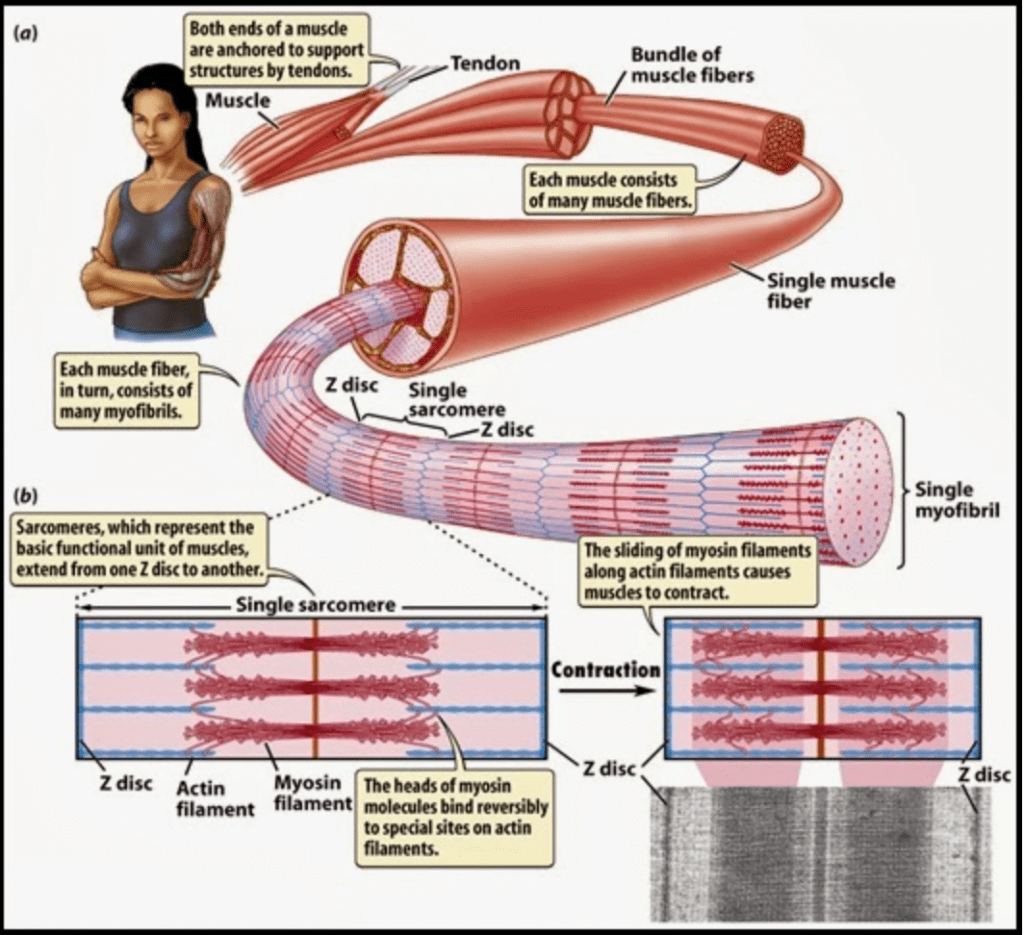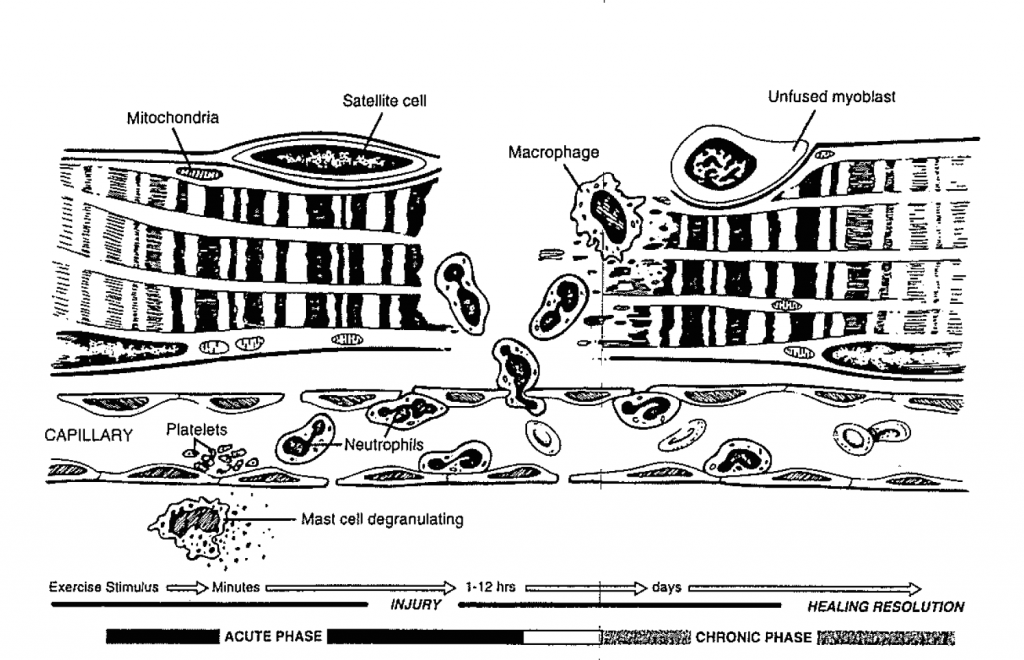
YOUR FITNESS BLOG
Muscle Soreness After A Workout? That's Called DOMS
What Is Delayed Onset Muscle Soreness?
Delayed onset muscle soreness (DOMS) is a familiar feeling for most lifters. It is a distinct feeling of discomfort in the working muscle that can range symptomatically from simple muscle tenderness to severely debilitating pain [3, 11]. What is interesting about exercise induced muscle soreness is that it typically increases in discomfort and begins with a generally pain-free period of about 24 hours after strenuous exercise [4, 11]. Pain symptoms then increase rapidly and typically peak at 24-72 hours following a workout and dissipate within 5-7 days following exercise [1, 2, 4, 11].
DOMS can be formally classified as a type I muscle strain injury and is the result of eccentric (lengthening) type of a movement like the lowering of free weights or running downhill. This movement is in contrast to the shortening (concentric) type of the movement [11, 6]. There have been a number of theories presented to explain DOMS. This blog post will examine the more popular theories in an effort develop a better understanding of the mechanisms behind this phenomenon.
Lactic Acid Theory
Most common among the general lifting population is the assumption that DOMS occurs from the accumulation of lactic acid. Lactic acid is a compound produced mainly in muscle cells and forms when the body breaks down carbohydrates under low oxygen levels (i.e. strenuous exercise or infection) [14]. The build up of metabolic waste in the form of lactic acid is thought to cause painful stimulation and the perception of pain at a delayed point [1, 6, 11, 14]. However, this theory has been widely rejected as lactic acid levels have been shown to return to pre-workout levels within 1 hour following strenuous exercise [3, 14]. Also, this hypothesis is negated by findings that show concentric (shortening) exercise, which involves a higher degree of metabolism, fails to elicit DOMS [5]. Therefore, lactic acid may explain the acute pain or soreness following intensive exercise, but it is not attributed to the delayed pain experienced 24-48 hours post exercise.
Muscle Spasm Theory
Many lifters have likely experienced involuntary muscle activity (spasming) following an intensive workout. It was theorised that increased resting muscle activity following eccentric exercise led to compression of local blood vessels, ischemia (inadequate blood supply to the muscles) and a build up of pain substances [2]. These factors were then thought to stimulate pain nerve endings and cause further muscle spasms, creating somewhat of a pain evoking cycle [2]. However, studies examining muscle spasms using electromyography (EMG) have been largely inconsistent with multiple studies showing no relationship with increased EMG activity and the perception of sore muscles [2].
Muscle Damage Theory
The muscle damage theory was first proposed by Hough in 1902 and remains one of the strongest explanations of DOMS [8]. This theory focuses on the mechanical damage to connective muscle tissue following strenuous eccentric exercise. Eccentric exercise places increased tension on the muscles creating microscopic lesions (small tares) in the muscle itself, specifically damaging the z-lines and muscle sarcomeres [1, 3, 4, 10]. During eccentric exercise, the force generated is approximately twice that developed during isometric exercise [8, 6]. Pain receptors located within the muscle connective tissue are then stimulated resulting in the sensation of pain [3].

Newham and colleagues (1983), found immediate muscle damage in the quadriceps muscle following eccentric exercise [12]. In their study, subjects performed a 20-minute step test, whereby the quadriceps muscle of one leg contracted concentrically throughout by stepping up, while the quadriceps muscle of the opposite leg contracted eccentrically by controlling the step down [12]. This study found marked muscle damage in the eccentrically controlled leg 24-48 hours post-exercise, while no muscle damage was found in the concentrically exercised leg [12]. The authors suggest that the initial muscle damage observed in the eccentrically exercised leg was related to mechanical damage to the connective tissue, reinforcing Hough’s muscle damage theory.

It is purposed that increased muscle tension alone is not the only cause of muscle damage, but rather the strain during active lengthening. Liber and Friden suggest the active strain of a muscle during eccentric lengthening exceeds that of the structure or framework of a muscle, therefore imparting muscle damage [9].
In further support of the muscle damage theory, creatine kinase (CK), a blood enzyme found exclusively in cardiac and skeletal muscle, rises significantly following eccentric exercise [2, 3]. CK is considered a reliable indicator of muscle membrane permeability and damage to the muscle from intensive exercise would enable diffusion of soluble muscle enzymes, like CK, into the interstitial fluid [2, 3]. In 1983, Newham and colleagues showed that CK levels increased from 400 IU/liter up to 34,500 IU/liter following exercise delivered in the form of an eccentric 20-minute step-test, indicating a strong connection between muscle damage and delayed muscle soreness [13].
Inflammation Theory
The inflammation theory is based on findings of an inflammatory response i.e. oedema (swelling) and cell infiltration following strenuous eccentric exercise. Following eccentric exercise, there is a rapid breakdown of muscle fibres and connective tissue and an accumulation of inflammatory mediators (bradykinin, prostaglandins and histamine) to the damaged site [7]. This is accompanied by an increase in protein-rich fluid (swelling) into the muscle following exercise [5]. The sensation of pain results from the increased fluid pressure (osmotic pressure) activating pain sensory neurons within the muscle [1, 3, 5, 15]. Also, peak swelling periods appear to coincide well with heightened levels of muscle soreness.
Furthermore, it has been argued that following eccentric exercise, monocytes and macrophages, which are defence cells, responsible for removal of waste from the damaged muscle, accumulate at the injured site and sensitise nerve endings around 24-48 hours post exercise [1, 15]. However, there is still controversy in the scientific literature as to whether swelling (oedema) and inflammatory cell infiltration is purely responsible for delayed muscle soreness post exercise.
Conclusions
As personal trainers, understanding the possible mechanisms behind DOMS is vital for client education and the circulation of evidence-based education. A review of the literature suggests that more than one theory alone can be used to explain the onset of DOMS. However, it can be safely argued that the process begins with application of high tensile muscle forces associated with eccentric exercise, which damage the muscle and connective tissue [3]. This is evidenced by damaged z-lines in the muscle and increased levels of the blood enzyme creatine kinase. This stage is immediately followed by swelling and inflammatory cell infiltration within the first few hours, which peak at about 48 hours post exercise. The sensation of pain is then a result of damage to the muscle itself and an exposure to the inflammatory environment that further sensitises pain nerve endings.
For more information on our services please click here to read more.
References:
1. Armstrong, R.B. 1984. Mechanisms of Exercise-Induced Delayed Onset Muscular Soreness: A Brief Review. Medicine and Science in Sports and Exercise. December. Vol. 16, No. 6, pp. 529–538.
2. Bobbert, M. F, et al. 1986. Factors in Delayed Onset Muscular Soreness of Man. Medicine and Science in Sports Exercise. February. Vol. 18 , No. 1, pp. 75-81.
3. Cheung, K. et al. 2003. Delayed Onset Muscle Soreness Treatment Strategies and Performance Factors. Sports Medicine. Vol. 33, No. 2, pp. 145-164.
4. Faulkner J. A. et al. 1993. Injury to skeletal muscle fibers during contractions: conditions of occurrence and prevention. Physical Therapy. December. Vol. 73, No. 12, pp. 911-921.
5. Friden, J. et al. 1986. Muscle soreness and intramuscular fluid pressure: comparison between eccentric and concentric load. Journal of Applied Physiology. December. Vol. 61, No. 6, pp. 2175-2179.
6. Gulick, D. T. & Kimura, I. F. 1996. Delayed Onset Muscle Soreness: What is it and How Do We Treat It? Journal of Sport Rehabilitation. August. Vol. 5, No. 3, pp. 234-243.
7. Hasson, S. M. et al. 1993. Effect of ibuprofen use on muscle soreness, damage, and performance: a preliminary investigation. Medicine & Science in Sports Exercise. January. Vol. 25, No. 1, pp. 9-17.
8. Hough, T. 1902. Ergographic Studies in Muscular Soreness. American Jouranl of Physiology. April. Vol. 7, pp. 76–92.
9. Lieber, R. L. & Friden. 1993. Muscle damage is not a function of muscle force but active muscle strain. Journal of Applied Physiology. February. Vol. 74, No. 2, pp. 520-526.
10. MacIntyre, D. L. et al. 1995. Delayed muscle soreness. The inflammatory response to muscle injury and its clinical implications. Sports Medicine. July. Vol. 20, No. 1, pp. 24-40.
11. Mizumura, K. & Taguchi, T. 2016. Delayed onset muscle soreness: Involvement of neurotrophic factors. The Journal of Physiological Sciences. January. Vol. 66, No. 1, pp. 43-52.
12. Newham et al. 1983. Large Delayed Plasma Creatine Kinase Changes After Stepping Exercise. Muscle & Nerve. June. Vol. 6, No. 5, pp. 380-385.
13. Newham et al. 1983. Ultrastructural changes after concentric and eccentric contractions of human muscle. Journal of the Neurological Sciences. September. Vol. 61, No. 1, pp. 109-122.
14. Schwane, J. A. et al. 1983. Is Lactic Acid Related to Delayed-Onset Muscle Soreness? The Physician and Sportsmedicine. January. Vol. 11, No. 3, pp.124–131.
15. Smith, L. L. 1991. Acute inflammation: the underlying mechanism in delayed onset muscle soreness? Medicine & Science in Sports Exercise. May Vol. 23, No. 5, pp. 542-551.

Did you find this content valuable?
Add yourself to our community to be notified of future content.

